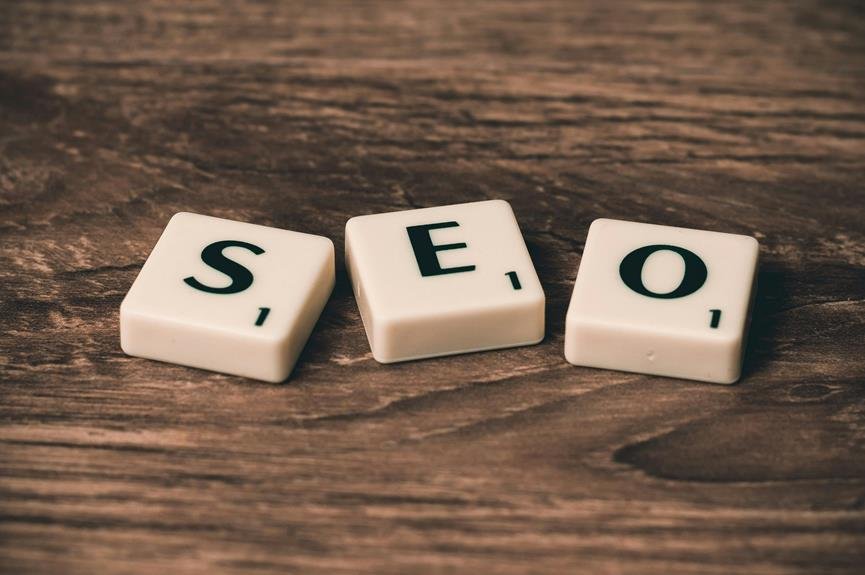Structured content organization is essential for boosting your website's SEO. It helps search engines understand what your site offers, improving how they index your content. By using headings, clear categories, and internal linking, you create a logical flow that's easy for users to navigate. This enhances both user experience and crawl efficiency. Additionally, structured content aligns your topics with user intent, making it easier to target relevant keywords and avoid competition between your own pages. Overall, a well-organized site signals credibility and value to search engines, which can greatly improve your online visibility. Discover more ways to optimize your content strategically.
Understanding Structured Content
Structured content is the backbone of effective SEO, enabling search engines to understand your website better. When you think about structured content, consider how it helps organize various content types like articles, videos, and infographics. By categorizing your content effectively, you make it easier for both users and search engines to navigate your site.
Audience targeting plays a vital role here. You need to know who your audience is and what they're looking for. Tailoring your content types to suit their preferences can greatly enhance user experience. For instance, if your audience prefers videos over articles, prioritize that format to keep them engaged.
Additionally, using structured data markup helps search engines grasp the context of your content, making it more likely that your site will appear in relevant search results. This isn't just about stuffing keywords; it's about creating a logical flow that makes sense to both users and algorithms.
Benefits for Search Engines
When you organize your content effectively, search engines benefit greatly. Enhanced crawl efficiency means they can find and index your pages faster, while improved keyword relevance helps them match your content with user queries more accurately. Ultimately, this boosts your visibility in search results, making it easier for potential visitors to discover your site.
Enhanced Crawl Efficiency
Optimizing your content organization can greatly enhance crawl efficiency for search engines. When your content is structured logically, it helps search engine bots navigate your site more easily. This improved navigation can lead to increased crawl frequency, meaning search engines will visit your site more often to index the latest updates.
By clearly defining categories, subcategories, and internal links, you're giving search engines a roadmap to your content. This organization facilitates better content indexing, allowing search engines to understand the relevance and context of each page. When search engines can quickly find and index your pages, they can serve your content to users more effectively in search results.
Moreover, a well-organized site reduces the chances of duplicate content and guarantees that your most important pages are prioritized during indexing. This organization not only enhances the user experience, making it easier for visitors to find what they're looking for, but it also signals to search engines that your site is credible and valuable. In short, investing time in structuring your content pays off, leading to better visibility and performance in search engine results.
Improved Keyword Relevance
Effective content organization directly boosts keyword relevance, which is essential for search engines. When you create content with a structured approach, you enhance the semantic relevance of your keywords. This not only helps your audience but also signals to search engines that your content is valuable and authoritative. By utilizing keyword clustering and content silos, you can group similar topics together, making it easier for search engines to understand your site's focus.
Here are some benefits you can expect from improved keyword relevance:
- Better alignment with search intent, ensuring your content meets user needs
- Increased effectiveness of long tail keywords, capturing niche audiences
- Reduction of keyword cannibalization, so you don't compete against your own pages
- Enhanced topical authority, establishing your site as a go-to resource
- More informed competitive analysis, helping you identify gaps in your content strategy
Enhancing User Experience
Enhancing user experience is vital for keeping visitors engaged on your website. When you focus on content accessibility, you make it easier for everyone to find and enjoy your content. Incorporating interactive elements can boost user engagement, encouraging visitors to explore more of what you offer. By maintaining a clear visual hierarchy, you guide your audience through your content smoothly, helping them understand what's most important.
Don't forget about mobile optimization; more users browse on their phones than ever, so make certain your site looks great on all devices. Readability factors like font size and line spacing greatly impact how easily users can digest your information. Gathering user feedback can provide valuable insights into their preferences and needs, allowing you to adjust your approach accordingly.
Understanding navigation patterns is essential, too. Clear menus and logical pathways enhance content discoverability, making it simple for users to find what they're looking for. Finally, effective audience targeting guarantees that your content resonates with the right people, fostering a more meaningful connection. By prioritizing these elements, you create a user experience that keeps visitors coming back for more.
Importance of Headings
Headings play an essential role in organizing your content and guiding readers through your website. They enhance readability by providing a clear heading structure, making it easier for visitors to find information that aligns with their user intent. By using appropriate heading types, you can create a visual hierarchy that captures attention and reinforces semantic relevance.
Here's how effective headings can benefit your content:
- Content Segmentation: Breaks up large blocks of text into digestible sections.
- Keyword Placement: Allows for strategic insertion of keywords, helping search algorithms rank your content better.
- Readability Factors: Improves the overall flow of your text, making it easier for readers to follow.
- User Engagement: Captures interest and encourages readers to stay on your page longer.
- SEO Benefits: Optimizes your content for search engines, enhancing visibility.
Clear Navigation Systems
A well-structured content layout is only part of the equation when it comes to user experience; clear navigation systems are equally important. When users land on your site, they should easily understand how to move around. Effective navigation patterns guide them through their user journeys, ensuring they find what they're looking for without frustration.
Think about your website's menu as a roadmap. It should provide a clear path to every important section of your site. Utilize simple, descriptive labels for each menu item, so users can immediately grasp where clicking will take them. A logical hierarchy also helps, grouping related content together, which allows visitors to navigate effortlessly.
Moreover, consider adding a search bar. This feature can be a lifesaver for users who prefer to jump straight to what they need instead of browsing. You want to make their journey as smooth as possible, reducing the chances they'll leave your site out of confusion or frustration.
Internal Linking Strategies
Your website's internal linking strategy plays an essential role in both SEO and user experience. By implementing linking best practices, you create clear crawl paths for search engines and enhance user engagement. Start by developing content silos that group related topics, making it easier for visitors to navigate your site. Also, verify that your navigation hierarchy reflects these silos, guiding users seamlessly from one piece of content to another.
Here are some effective internal linking strategies to reflect upon:
- Anchor text optimization: Use relevant keywords in your anchor text to provide context and improve search visibility.
- Contextual relevance: Link to related topics within your content, enhancing the reader's understanding and keeping them on your site longer.
- Link equity: Distribute authority across your pages, verifying that your most valuable content receives the attention it deserves.
- Interlinking patterns: Create a logical flow between articles to maintain a cohesive reading experience.
- User engagement: Encourage visitors to explore more by strategically placing links that lead to additional resources.
Content Hierarchy and Flow
Establishing a clear content hierarchy is essential for guiding both search engines and users through your website. When you organize your content types effectively, you create a visual hierarchy that enhances audience targeting. This means that users can easily identify main ideas, while search engines can better understand your semantic structure.
To achieve this, focus on content themes and how they relate to each other. Start with strong headings that reflect your main topics, and use subheadings to break down those ideas. This approach not only improves readability factors but also helps with content segmentation, making it easier for users to navigate.
Your page layout plays a critical role here, too. By grouping related information together and using bullet points or numbered lists, you increase clarity. Remember that a logical flow from one section to another keeps readers engaged and encourages them to explore more of your content. Ultimately, a well-structured hierarchy not only enhances user experience but also boosts your SEO efforts, making it a win-win for everyone involved. So, take the time to refine your content hierarchy, and watch your site thrive!
Tools for Content Organization
When it comes to organizing your content effectively, the right tools can make all the difference. Whether you're using a content management system, mind mapping software, or SEO analysis tools, each option offers unique benefits to streamline your process. Let's explore how these tools can enhance your content organization and ultimately improve your SEO efforts.
Content Management Systems
A robust content management system (CMS) is vital for effective content organization and optimization. With the right CMS, you can streamline your content lifecycle, making it easier to manage everything from creation to updates. It supports a clear content structure, guaranteeing your data organization is efficient and logical.
Here are some key features to look for in a CMS:
- Metadata implementation: Helps improve SEO by optimizing how search engines read your content.
- Taxonomy design: Allows you to categorize and organize content effectively, enhancing user engagement.
- Content tagging: Simplifies retrieval and improves navigation, making it easier for users to find what they need.
- Template usage: guarantees consistency across your content, which is vital for branding and accessibility.
- Version control: Keeps track of changes and allows you to revert to earlier versions if needed.
A good CMS enhances content accessibility, making it easier for users to interact with your site. By leveraging these features, you can maximize your SEO efforts, guaranteeing your content is not just well-organized, but also easily discoverable.
Mind Mapping Software
Release your creativity and streamline your content organization with mind mapping software. These tools are perfect for anyone looking to enhance their content strategy. By using mind mapping techniques, you can visually organize your ideas, making it easier to see connections and relationships between different topics. This visual brainstorming approach helps you generate new ideas and refine your existing ones, leading to more structured and coherent content.
Whether you're planning a blog post, an article, or an entire website, mind mapping software allows you to break down complex concepts into manageable sections. Start by placing your main idea at the center, then branch out with subtopics and supporting points. This method not only clarifies your thoughts but also reveals gaps in your content that need addressing.
Many mind mapping tools come equipped with features like drag-and-drop functionality, collaboration options, and templates, making it simple for you to customize your maps. By incorporating these tools into your content organization process, you'll not only improve your workflow but also enhance your overall SEO strategy. So, grab a mind mapping tool and start visualizing your ideas today!
SEO Analysis Tools
To optimize your content organization, leveraging SEO analysis tools is essential. These tools help you understand your site's performance and identify areas for improvement. By utilizing keyword tracking and competitor analysis, you can pinpoint the keywords that matter most and see how you stack up against others in your niche. Content auditing allows you to review your existing content, ensuring it aligns with user intent and identifies content gaps that need filling.
Here are some key features to look for in SEO analysis tools:
- Performance metrics: Track important data points to measure your content's success.
- SEO benchmarks: Compare your results against industry standards to gauge effectiveness.
- Data visualization: Easily interpret complex data through visual formats like charts and graphs.
- Traffic sources: Understand where your visitors are coming from to tailor your strategy.
- Ranking factors: Analyze what influences your rankings to enhance your content's visibility.
Conclusion
To sum up, think of structured content organization as the framework of a well-built house—it keeps everything in place and makes it easier to navigate. By prioritizing clear headings, smooth navigation, and effective internal linking, you not only help search engines understand your content but also enhance the user experience. When you invest time in organizing your content, you create a welcoming space that guides visitors effortlessly, ultimately leading to better engagement and improved SEO performance.





Leave a Reply